World Roundup
May/June 2014


-
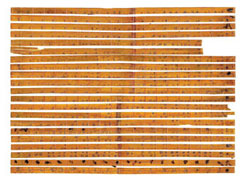 CHINA: Experts have revealed a multiplication table that might have been used to calculate land area, crop yields, and taxes during the Warring States Period, around 305 B.C. The table was among 2,500 bamboo strips that contain many significant historical texts donated to a university in Beijing. Twenty-one of them contain numbers and, when properly arranged, allow for the multiplication of whole and half integers from 0.5 to 99.5. It is among the oldest and most sophisticated tabular calculators known.
CHINA: Experts have revealed a multiplication table that might have been used to calculate land area, crop yields, and taxes during the Warring States Period, around 305 B.C. The table was among 2,500 bamboo strips that contain many significant historical texts donated to a university in Beijing. Twenty-one of them contain numbers and, when properly arranged, allow for the multiplication of whole and half integers from 0.5 to 99.5. It is among the oldest and most sophisticated tabular calculators known. -
 INDIA: Queen Ketevan ruled a small Christian kingdom in eastern Georgia. After her death in Iran in 1624—she was tortured after refusing to convert to Islam—her remains were unearthed and her right arm was taken to a convent in Goa. The convent had fallen into ruins by the 19th century, but excavations turned up bone fragments. Scientists found a genetic signature in the bones that is found in Georgia but not India, suggesting they have identified some portion of the lost martyr’s relic. —Samir S. Patel
INDIA: Queen Ketevan ruled a small Christian kingdom in eastern Georgia. After her death in Iran in 1624—she was tortured after refusing to convert to Islam—her remains were unearthed and her right arm was taken to a convent in Goa. The convent had fallen into ruins by the 19th century, but excavations turned up bone fragments. Scientists found a genetic signature in the bones that is found in Georgia but not India, suggesting they have identified some portion of the lost martyr’s relic. —Samir S. Patel -
 IRAQ: The Royal Diary of Alexander the Great describes his death in Babylon in 323 B.C. as an agonizing 12 days of fever, weakness, pain, and vomiting. The latest theory on the cause of his demise is poisoning with a plant called white hellebore. Toxicologists found that hellebore poisoning matches many of Alexander’s symptoms. Others disagree, stating that the symptoms would have been recognized by his doctor—unless, of course, his doctor had been part of a murder conspiracy (as legend has it). —Samir S. Patel
IRAQ: The Royal Diary of Alexander the Great describes his death in Babylon in 323 B.C. as an agonizing 12 days of fever, weakness, pain, and vomiting. The latest theory on the cause of his demise is poisoning with a plant called white hellebore. Toxicologists found that hellebore poisoning matches many of Alexander’s symptoms. Others disagree, stating that the symptoms would have been recognized by his doctor—unless, of course, his doctor had been part of a murder conspiracy (as legend has it). —Samir S. Patel -
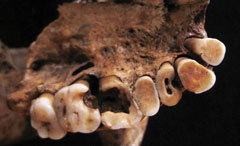 MOROCCO: Tooth decay occurs when bacteria consume trapped food and produce acid that breaks down hard dental tissue. These bacteria thrived when humans took up farming; ancient hunter-gatherers appear to have had few cavities. Not so the people of Grotte Des Pigeons 15,000 to 12,000 years ago. New analysis of dentition shows that they had as many cavities as modern populations do. This could have been due to a diet heavy in acorns and other carbs that are appealing to the agents of tooth decay. —Samir S. Patel
MOROCCO: Tooth decay occurs when bacteria consume trapped food and produce acid that breaks down hard dental tissue. These bacteria thrived when humans took up farming; ancient hunter-gatherers appear to have had few cavities. Not so the people of Grotte Des Pigeons 15,000 to 12,000 years ago. New analysis of dentition shows that they had as many cavities as modern populations do. This could have been due to a diet heavy in acorns and other carbs that are appealing to the agents of tooth decay. —Samir S. Patel -
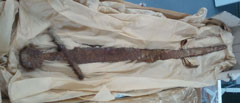 FINLAND: Metal detectorists found a fascinating grave in a field in Janakkala and turned the find over to archaeological authorities. The well-preserved body dates to the Northern Crusades, in the 12th and 13th centuries, when Christian Swedes and Danes invaded pagan areas of Northern Europe. The individual, perhaps a well-off soldier, was buried with two swords: a broken Viking-era piece and an intact one from his own time. At nearly four feet from pommel to point, it one of the longest ever found in Finland. —Samir S. Patel
FINLAND: Metal detectorists found a fascinating grave in a field in Janakkala and turned the find over to archaeological authorities. The well-preserved body dates to the Northern Crusades, in the 12th and 13th centuries, when Christian Swedes and Danes invaded pagan areas of Northern Europe. The individual, perhaps a well-off soldier, was buried with two swords: a broken Viking-era piece and an intact one from his own time. At nearly four feet from pommel to point, it one of the longest ever found in Finland. —Samir S. Patel -
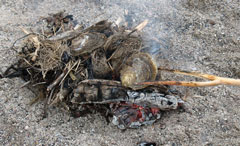 DENMARK: Fresh oysters are worth the elbow grease and tricky leverage needed to pry them open, but that’s not the only option. The thick Mesolithic middens near the village of Ertebølle are full of oyster shells, but bear no evidence of tools to open them or damage from the process. Rather, some show signs of light scorching. Experiments show that after brief heating on hot stone or embers, oysters ease open with a puff of steam. But the researchers involved disagree on whether the process affects the taste. —Samir S. Patel
DENMARK: Fresh oysters are worth the elbow grease and tricky leverage needed to pry them open, but that’s not the only option. The thick Mesolithic middens near the village of Ertebølle are full of oyster shells, but bear no evidence of tools to open them or damage from the process. Rather, some show signs of light scorching. Experiments show that after brief heating on hot stone or embers, oysters ease open with a puff of steam. But the researchers involved disagree on whether the process affects the taste. —Samir S. Patel -
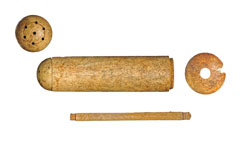 NEW YORK: In 2010, in a heap under City Hall Park in lower Manhattan, archaeologists found alcohol bottles, pipes, and bones, including those of turtles, which would have been a delicacy. The soiree deposit dates to the early 19th century, right around when City Hall was built. Researchers have only just determined the identity of an odd cylindrical device carved from bone, with a perforated cap. Comparisons with museum objects reveal it to be a syringe for feminine hygiene—a douche. —Samir S. Patel
NEW YORK: In 2010, in a heap under City Hall Park in lower Manhattan, archaeologists found alcohol bottles, pipes, and bones, including those of turtles, which would have been a delicacy. The soiree deposit dates to the early 19th century, right around when City Hall was built. Researchers have only just determined the identity of an odd cylindrical device carved from bone, with a perforated cap. Comparisons with museum objects reveal it to be a syringe for feminine hygiene—a douche. —Samir S. Patel -
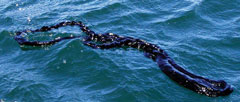 CALIFORNIA: Bitumen, or natural petroleum tar, has been a useful material around the world for thousands of years. In the Channel Islands, the Chumash used it as long as 8,000 years ago as an adhesive or to waterproof baskets or boats, but the islands have no terrestrial source. They could have traded for some, but scientists applied geochemical analysis and traced samples used by the Chumash back to a petroleum seep 25 miles offshore. The bitumen washed ashore in the form of “tar balls” or “tar whips.” —Samir S. Patel
CALIFORNIA: Bitumen, or natural petroleum tar, has been a useful material around the world for thousands of years. In the Channel Islands, the Chumash used it as long as 8,000 years ago as an adhesive or to waterproof baskets or boats, but the islands have no terrestrial source. They could have traded for some, but scientists applied geochemical analysis and traced samples used by the Chumash back to a petroleum seep 25 miles offshore. The bitumen washed ashore in the form of “tar balls” or “tar whips.” —Samir S. Patel -
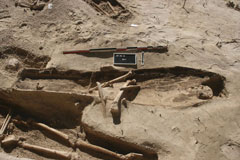 GUADELOUPE: Coastal erosion on the island of Grand-Terre has put a colonial-era graveyard at risk. The beachside cemetery has been known since the 1990s, when a skull with a slave collar surfaced. Archaeologists have now revealed almost 50 graves, including an individual with cut incisors, suggesting African origins. It is estimated that hundreds more graves remain, as the cemetery was used for around a century. The French territory had a large population of slaves working on sugar plantations until the mid-19th century. —Samir S. Patel
GUADELOUPE: Coastal erosion on the island of Grand-Terre has put a colonial-era graveyard at risk. The beachside cemetery has been known since the 1990s, when a skull with a slave collar surfaced. Archaeologists have now revealed almost 50 graves, including an individual with cut incisors, suggesting African origins. It is estimated that hundreds more graves remain, as the cemetery was used for around a century. The French territory had a large population of slaves working on sugar plantations until the mid-19th century. —Samir S. Patel -
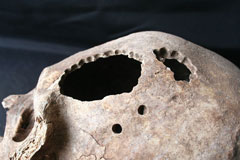 PERU: A new study of dozens of skulls from the south-central Andes examined the practice of trepanation, or the surgical removal of a portion of the skull. Researchers theorize that the practice arose following the collapse of the Wari Empire around A.D. 1000, which may have brought increased violence and health problems that required new, and sometimes radical, treatments. The study shows that primarily adult men were eligible, that scraping offered better outcomes than drilling, and that some skulls were used for practice after death. —Samir S. Patel
PERU: A new study of dozens of skulls from the south-central Andes examined the practice of trepanation, or the surgical removal of a portion of the skull. Researchers theorize that the practice arose following the collapse of the Wari Empire around A.D. 1000, which may have brought increased violence and health problems that required new, and sometimes radical, treatments. The study shows that primarily adult men were eligible, that scraping offered better outcomes than drilling, and that some skulls were used for practice after death. —Samir S. Patel
Advertisement
IN THIS ISSUE
From the Trenches
A Brief Glimpse into Early Rome
Off the Grid
Port of the Pyramids
Hardening Brittle Bones
First American Family Tree
Recreating Nordic Grog
The Goddess' Brewer
Peeping through the Leaves
Clash of the War Elephants
England's Oldest Footprints
Secrets of Bronze Age Cheese Makers
Our Lady of the Lake
Big Data, Big Cities
Advertisement

Recent Issues
-
 May/June 2024
May/June 2024
-
 March/April 2024
March/April 2024
-
 January/February 2024
January/February 2024
-
 November/December 2023
November/December 2023
-
 September/October 2023
September/October 2023
-
 July/August 2023
July/August 2023
-
 May/June 2023
May/June 2023
-
 March/April 2023
March/April 2023
-
 January/February 2023
January/February 2023
-
 November/December 2022
November/December 2022
-
 September/October 2022
September/October 2022
-
 July/August 2022
July/August 2022
-
 May/June 2022
May/June 2022
-
 March/April 2022
March/April 2022
-
 January/February 2022
January/February 2022
-
 November/December 2021
November/December 2021
-
 September/October 2021
September/October 2021
-
 July/August 2021
July/August 2021
-
 May/June 2021
May/June 2021
-
 March/April 2021
March/April 2021
-
 January/February 2021
January/February 2021
-
 November/December 2020
November/December 2020
-
 September/October 2020
September/October 2020
-
 July/August 2020
July/August 2020
-
 May/June 2020
May/June 2020
-
 March/April 2020
March/April 2020
-
 January/February 2020
January/February 2020
-
 November/December 2019
November/December 2019
-
 September/October 2019
September/October 2019
-
 July/August 2019
July/August 2019
-
 May/June 2019
May/June 2019
-
 March/April 2019
March/April 2019
-
 January/February 2019
January/February 2019
-
 November/December 2018
November/December 2018
-
 September/October 2018
September/October 2018
-
 July/August 2018
July/August 2018
-
 May/June 2018
May/June 2018
-
 March/April 2018
March/April 2018
-
 January/February 2018
January/February 2018
-
 November/December 2017
November/December 2017
-
 September/October 2017
September/October 2017
-
 July/August 2017
July/August 2017
-
 May/June 2017
May/June 2017
-
 March/April 2017
March/April 2017
-
 January/February 2017
January/February 2017
-
 November/December 2016
November/December 2016
-
 September/October 2016
September/October 2016
-
 July/August 2016
July/August 2016
-
 May/June 2016
May/June 2016
-
 March/April 2016
March/April 2016
-
 January/February 2016
January/February 2016
-
 November/December 2015
November/December 2015
-
 September/October 2015
September/October 2015
-
 July/August 2015
July/August 2015
-
 May/June 2015
May/June 2015
-
 March/April 2015
March/April 2015
-
 January/February 2015
January/February 2015
-
 November/December 2014
November/December 2014
-
 September/October 2014
September/October 2014
-
 July/August 2014
July/August 2014
-
 May/June 2014
May/June 2014
-
 March/April 2014
March/April 2014
-
 January/February 2014
January/February 2014
-
 November/December 2013
November/December 2013
-
 September/October 2013
September/October 2013
-
 July/August 2013
July/August 2013
-
 May/June 2013
May/June 2013
-
 March/April 2013
March/April 2013
-
 January/February 2013
January/February 2013
-
 November/December 2012
November/December 2012
-
 Sep/Oct 2012
Sep/Oct 2012
-
 September/October 2012
September/October 2012
-
 July/August 2012
July/August 2012
-
 May/June 2012
May/June 2012
-
 March/April 2012
March/April 2012
-
 January/February 2012
January/February 2012
-
 November/December 2011
November/December 2011
-
 September/October 2011
September/October 2011
-
 July/August 2011
July/August 2011
-
 May/June 2011
May/June 2011
-
 March/April 2011
March/April 2011
-
 January/February 2011
January/February 2011
Advertisement






